World War II
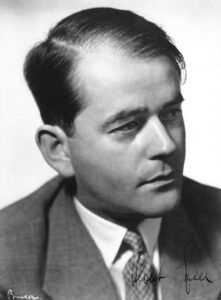 As Hitler continued his reign of terror over the people of Germany, in his quest to rule the world, he decided that he needed to destroy much of the German infrastructure so that the Allied forces couldn’t use it as they penetrated deep withing the borders of Germany. Hitler must have known by now that he was losing this war, even in his crazed state, so he was trying to find a way to turn the tide.
As Hitler continued his reign of terror over the people of Germany, in his quest to rule the world, he decided that he needed to destroy much of the German infrastructure so that the Allied forces couldn’t use it as they penetrated deep withing the borders of Germany. Hitler must have known by now that he was losing this war, even in his crazed state, so he was trying to find a way to turn the tide.
The Nero Decree (German: Nerobefehl) was the order issued by Hitler on March 19, 1945, right after the Allies captured the final bridge on the Rhine River that allowed access into Germany. The Nero Decree ordered the destruction of large numbers of bridges in Germany. The official name was Decree Concerning Demolitions in the Reich Territory (Befehl betreffend Zerstörungsmaßnahmen im Reichsgebiet), but that is rather a long name, so it became known as the Nero Decree, after the Roman Emperor Nero, who, according to an apocryphal story, “engineered the Great Fire of Rome in 64 AD.”
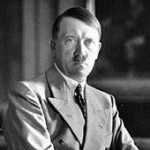
This act would have wiped out all of Germany’s industry and infrastructure just to keep it from falling under Allied control. Hitler didn’t care about that or about the people who would be affected. The actual task of carrying out such destruction fell to Germany’s armaments minister…and Hitler’s friend, Albert Speer. Speer knew that to follow the order would have a ruinous effect on the German people, so like Von Choltitz, who had disobeyed the order to burn Paris, Speer deliberately disobeyed the order of his friend, who he suspected was mentally unstable. In addition, Speer also issued encrypted alternate orders to delay the destruction. In the end, the Nero Decree wasn’t carried out at all, something which I’m quite certain drove Hitler totally insane.
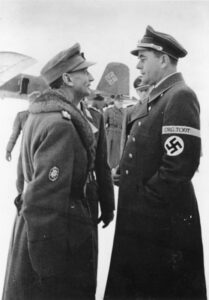
Speer was one of the highest-ranking members of German leadership to survive the war. He attempted to promote himself as someone who stood up to Hitler. While history does credit him with refusing to follow the Nero Decree, it did not completely exonerate him. Speer was an architect, and he wanted to preserve many buildings he had designed. Berthold Konrad Hermann Albert Speer, born March 19, 1905, in Mannheim, into an upper-middle-class family. He was the second of three sons of Luise Máthilde Wilhelmine (Hommel) and Albert Friedrich Speer. He was a German architect who served as the Minister of Armaments and War Production in Nazi Germany during most of World War II. He was also a close ally of Adolf Hitler, a relationship which would cause him to be convicted at the Nuremberg trials and sentenced to 20 years in prison. Speer returned to London in 1981 to participate in the BBC Newsnight program. He suffered a stroke and died in London on September 1, 1981.
 While there were those who thought it wasteful to build the lavish Temppeliaukio Church, a Lutheran church in the Toolo neighborhood of Helsinki, Finland. Before the construction of the church was even fully complete it made headlines when on the nights of July 16 and 17, 1968 a group of Christian students painted in large letters “BIAFRA” in several places on the exterior walls of the building to bring attention to the famine then going on in Biafra, which had declared independence from Nigeria in 1967. The students, part of the 1960s student revolutionary movement, thought they were doing a service to the people of Biafra, but they were simply young and naive, and they didn’t know that one thing had nothing to do with the other, because were the funds not used in the church, they would have been used for something else. Building the church or not building the church would make no difference for the people of Biafra.
While there were those who thought it wasteful to build the lavish Temppeliaukio Church, a Lutheran church in the Toolo neighborhood of Helsinki, Finland. Before the construction of the church was even fully complete it made headlines when on the nights of July 16 and 17, 1968 a group of Christian students painted in large letters “BIAFRA” in several places on the exterior walls of the building to bring attention to the famine then going on in Biafra, which had declared independence from Nigeria in 1967. The students, part of the 1960s student revolutionary movement, thought they were doing a service to the people of Biafra, but they were simply young and naive, and they didn’t know that one thing had nothing to do with the other, because were the funds not used in the church, they would have been used for something else. Building the church or not building the church would make no difference for the people of Biafra.
The Temppeliaukio Church was designed by architects and brothers Timo and Tuomo Suomalainen and opened in 1969. It was uniquely built directly into solid rock. It is known as the “Church of the Rock” and “Rock Church.” Plans for the Temppeliaukio/Tempelplatsen (Temple square) began as early as the 1930s when a plot of land was selected for the building. It was decided to hold a competition for the design of the church. The plan by JS Siren, who was the winner of the second competition to design the architecture of the church, was interrupted in its early stages when World War II began in 1939. After the war, that design was scrapped and there was another architectural competition. That competition was won by Timo Suomalainen and Tuomo Suomalainen in 1961. Even that plan had to be somewhat changed when, for economic reasons, it was scaled  back, and the interior space of the church was reduced to about one-quarter of its original plan. I suppose that when you think about it, cutting a church into solid rock would be a complicated and costly operation. The long-awaited Construction finally began in February 1968, and the rock-temple was completed for consecration in September 1969.
back, and the interior space of the church was reduced to about one-quarter of its original plan. I suppose that when you think about it, cutting a church into solid rock would be a complicated and costly operation. The long-awaited Construction finally began in February 1968, and the rock-temple was completed for consecration in September 1969.
As planned, the interior was carved out of solid rock. It is beautifully bathed in natural light which enters through the skylight surrounding the center copper dome. Strangely, the church reminds me of a spaceship, a little bit anyway, but I find it to be beautiful and quite peaceful too. The church is used frequently as a concert venue due to its excellent natural acoustics. The acoustic quality is created by the rough, virtually unworked rock surfaces. The iconic rock walls were not included in the original competition entry, even though the Suomalainen brothers had considered the idea, because they believed that it was too radical for the competition jury. I suppose thy wondered if it would be looked at as sacrilegious or maybe too backward to be beautiful… how very wrong they were about that. But when conductor Paavo Berglund shared his knowledge of acoustics from some of the best music halls and the acoustical engineer Mauri Parjo gave requirements for the wall surfaces, the Suomalainen brothers discovered that they could fulfill all the requirements for the acoustics by leaving the rock walls exposed in the Church Hall. It was also a financial savings both then and, in the future, as it eliminated the need to paint the interior.
Today, the Temppeliaukio church is one of the most popular tourist attractions in the city, with half a million people visiting it annually. The stone-hewn church is located in the heart of Helsinki, giving people easy access  to its beauty and solace. Maintaining the original character of the square is the fundamental concept behind the building. The idiosyncratic choice of form has made it a favorite with professionals and aficionados of architecture. I can imagine that many of them come to see it simply to admire the perfection of this almost artistic masterpiece. The church furnishings were designed by the architects. Organ builder Veikko Virtanen manufactured the church organ, which has 43 stops and 3001 pipes. In an unusual anomaly, there are no bells at the church. Instead, a recording of bells composed by Taneli Kuusisto is played via loudspeakers on the exterior wall calls parishioners to the services.
to its beauty and solace. Maintaining the original character of the square is the fundamental concept behind the building. The idiosyncratic choice of form has made it a favorite with professionals and aficionados of architecture. I can imagine that many of them come to see it simply to admire the perfection of this almost artistic masterpiece. The church furnishings were designed by the architects. Organ builder Veikko Virtanen manufactured the church organ, which has 43 stops and 3001 pipes. In an unusual anomaly, there are no bells at the church. Instead, a recording of bells composed by Taneli Kuusisto is played via loudspeakers on the exterior wall calls parishioners to the services.
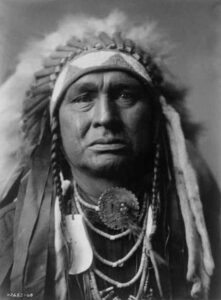 Joe Medicine Crow did not set out to become a war chief…much less the last surviving war chief, but when World War II drew the Unted States into the fight, Medicine Crow knew he couldn’t just sit back in his college dorm and refuse to help. Joe Medicine Crow was born on a reservation near Lodge Grass, Montana in 1913. Raised in the warrior tradition of the Crow, he was never one to shirk his duty in battle. He had some great warrior role models to fashion himself after, like his step-grandfather, who had been a scout for Custer at the infamous Battle of Little Bighorn, and his paternal grandfather Chief Medicine Crow who was one of the greatest Crow war heroes.
Joe Medicine Crow did not set out to become a war chief…much less the last surviving war chief, but when World War II drew the Unted States into the fight, Medicine Crow knew he couldn’t just sit back in his college dorm and refuse to help. Joe Medicine Crow was born on a reservation near Lodge Grass, Montana in 1913. Raised in the warrior tradition of the Crow, he was never one to shirk his duty in battle. He had some great warrior role models to fashion himself after, like his step-grandfather, who had been a scout for Custer at the infamous Battle of Little Bighorn, and his paternal grandfather Chief Medicine Crow who was one of the greatest Crow war heroes.
Before the war broke out, Medicine Crow enrolled at the University of Southern California and earned a master’s degree for his thesis, “The Effects of European Culture Contacts Upon the Economic, Social, and Religious Life of the Crow Indians.” With that, he became the first Crow to earn a master’s degree. After his graduation, he moved to Oregon to work at a Native American school and planned to pursue his Ph D, but then World War II broke out. Medicine Crow told a reporter for the Billings Gazette, “I had an uncle who had other plans for me…Uncle Sam.”
Medicine Crow hadn’t planned on entering the military, but he knew how to fight, and even while he was doing his duty to his country, he was still very aware of his family history. When he was a boy, his grandfather, Yellowtail put him through traditionally rigorous physical training meant to toughen him up. This included running in the snow barefoot and swimming in freezing rivers. His childhood was spent undergoing hardcore Spartan-style feats of strength, piledriving buffalo, riding horses bareback, swimming through mighty rivers, punching things, and running barefoot through snow-covered plains “uphill both ways.” He was taught to control his fear in the face of imminent peril, learned to hunt dangerous animals by himself, and trained his body to survive prolonged exposure to extreme temperatures. This training made him uniquely qualified for the hardships of a foot soldier. He came from a long line of famous warriors, and he kept them in mind when he was sent to Germany. He said, “I had a legacy to live up to.” Still, it was not something he told people about. That was his own legacy to live up to, and it was private. Throughout the war, he wore his war paint under his uniform, and he tucked a sacred yellow eagle feather under his helmet. He was determined to bring honor to his country and to his Crow people.
After the war, he worked for the Crow tribe and later became an appraiser for the Bureau of Indian Affairs, while also working as a Crow historian. While he didn’t get to go back to college, the University of Southern California (his alma mater) eventually awarded him an honorary doctorate in 2003, a degree I think he earned quite honorably.
“War Chief of the Crow Indians” isn’t a title that is given to just any warrior or chief. You don’t become a War Chief just because of your longevity of years or your physical strength. It’s an ancient, prestigious honorific bestowed only upon the bravest, the strongest warrior chiefs, and the only way to attain this hallowed title is by proving yourself in combat and unlocking the four achievements the Crow believed to be the most “insanely difficult” things a warrior can attempt in battle. These four major coups…leading a successful war party on a raid, capturing an enemy’s weapon, touching an enemy without killing him, and stealing an enemy’s horse. Some of those may sound odd to us, but to the Crow tribe, these were indeed major coups. These were difficult and dangerous tasks to attempt. In fact, they required that he put his life on the line by voluntarily bringing himself face-to-face with at least one warrior who is presumably in the process of actively trying to kill you without giving it a second thought. It was the Crow tribe’s way of ensuring that the chief leading them into battle was the bravest and best there was…and Joseph Medicine Crow was just that…the bravest and the best.
As an infantry scout, Private Medicine Crow got the opportunity to lead a group of men into battle in snow-covered battlefields of Western France while the Allies made their push from Paris towards Berlin…his first coup. It was during one particularly nasty portion of the battle for the Rhine, that Medicine Crow’s commanding officer ordered him to take a team of seven soldiers and lead them across a field of barbed wire, bullets, and artillery fire, grab some dynamite from an American position that had been utterly annihilated, and then assault the German bunkers and blow them up with TNT. It was a suicide mission, but according to Medicine Crow, his CO’s exact words were, “if anyone can do this, it’s probably you.”
His second and third coups followed quickly, when after being separated from his unit, Medicine Crow was sprinting through a back yard. He ran head on into a Nazi, who immediately lost his weapon. Not wanting to kill an unarmed man, Medicine Crow threw down his own weapon and proceeded to fist fight the Nazi. When the Nazi almost got the upper hand, Medicine Crow turned the tables and began to choke the life out of the guy…until the man started screaming for his mommy. That took “the kill” out of Medicine Crow, so he let the guy 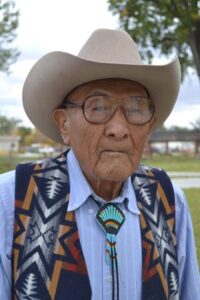 live. He took he German (and his rifle) as a prisoner of war.
live. He took he German (and his rifle) as a prisoner of war.
The fourth coup came in a rather unusual way. Joe and his men on a scouting mission deep behind enemy lines. While surveying the landscape for enemy troop movements, the small team of recon experts just happened to come across a small farm where some senior members of the German officer staff were hiding out…with their awesome thoroughbred racehorses. Seriously, how could Joseph Medicine Crow pass that up. So, he just had to steal them…and with that he had met all the requirements for becoming a “War Chief of the Crow Indians.” In August of 2009, Chief Medicine Crow was awarded the Presidential Medal of Freedom…the highest honor awarded to American civilians…for his combined military service and all the work he has done to help improve the lives of the people of the Crow people. The 95-year-old Medicine Crow personally led the ceremonial dance after the ceremony. Joseph Medicine Crow was the last surviving War Chief of the Crow Indians when he died in 2016, at 102 years old.
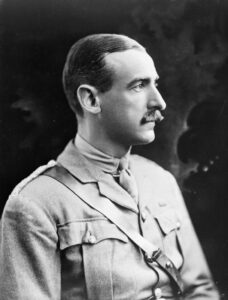 The unkillable soldier…a nickname that has deep ramifications, and a nickname no one really wants to have. It indicates that the soldier is wounded multiple times…and somehow survived. General Adrian Carton de Wiart was that soldier. He was born into an aristocratic family in Brussels, on May 5, 1880. He was the eldest son of Léon Constant Ghislain Carton de Wiart and Ernestine Wenzig. He spent his early days in Belgium and in England. When he was six years old, his parents divorced, and he moved with his father to Cairo. His mother remarried Demosthenes Gregory Cuppa later in 1886. His father was a lawyer and magistrate, as well as a director of the Cairo Electric Railways and Heliopolis Oases Company and was well connected in Egyptian governmental circles. Adrian Carton de Wiart learned to speak Arabic. He joined the British Army at the time of the Second Boer War around 1899, where he entered under the false name of “Trooper Carton,” claiming to be 25 years old, but he was actually 20. He was wounded in the stomach and groin in South Africa early in the Second Boer War and was sent home to recuperate. His father was furious when he learned his son had abandoned his studies. Nevertheless, he allowed his son to remain in the army.
The unkillable soldier…a nickname that has deep ramifications, and a nickname no one really wants to have. It indicates that the soldier is wounded multiple times…and somehow survived. General Adrian Carton de Wiart was that soldier. He was born into an aristocratic family in Brussels, on May 5, 1880. He was the eldest son of Léon Constant Ghislain Carton de Wiart and Ernestine Wenzig. He spent his early days in Belgium and in England. When he was six years old, his parents divorced, and he moved with his father to Cairo. His mother remarried Demosthenes Gregory Cuppa later in 1886. His father was a lawyer and magistrate, as well as a director of the Cairo Electric Railways and Heliopolis Oases Company and was well connected in Egyptian governmental circles. Adrian Carton de Wiart learned to speak Arabic. He joined the British Army at the time of the Second Boer War around 1899, where he entered under the false name of “Trooper Carton,” claiming to be 25 years old, but he was actually 20. He was wounded in the stomach and groin in South Africa early in the Second Boer War and was sent home to recuperate. His father was furious when he learned his son had abandoned his studies. Nevertheless, he allowed his son to remain in the army.
In 1908, he married Countess Friederike Maria Karoline Henriette Rosa Sabina Franziska Fugger von Babenhausen (1887 – 1949), eldest daughter of Karl, 5th Fürst (Prince) von Fugger-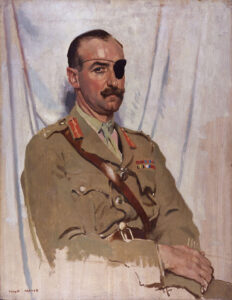 Babenhausen and Princess Eleonora zu Hohenlohe-Bartenstein und Jagstberg of Klagenfurt, Austria. They had two daughters, the elder of whom Anita (born 1909, now deceased) was the maternal grandmother of the war correspondent Anthony Loyd (born 1966). I wonder if Loyd was inspired by his grandfather’s story.
Babenhausen and Princess Eleonora zu Hohenlohe-Bartenstein und Jagstberg of Klagenfurt, Austria. They had two daughters, the elder of whom Anita (born 1909, now deceased) was the maternal grandmother of the war correspondent Anthony Loyd (born 1966). I wonder if Loyd was inspired by his grandfather’s story.
Over the course of his career, General Adrian Carton de Wiart earned the nickname “the unkillable soldier.” By 1915, he was promoted to captain and had already survived his first war…the Boer War. One night, near the French battlefield of Ypres, he and a small group of officers wandered too far into enemy territory and ran into a group of German soldiers, who fired. De Wiart was badly shot in the hand but scrambled back to his regiment. According to his memoirs, he used a “scarf he’d taken off a slain German soldier to stop the bleeding.” He was taken to a hospital where surgeons debated what to do about the gory mess of dangling fingers that had been his hand. De Wiart said, “I asked the doctor to take my fingers off; he refused, so I pulled them off myself and felt absolutely no pain in doing it.” De Wairt’s injuries were not over yet. The hand became infected and later had to be amputated. Three weeks later, De Wiart and returned to duty. He was shot several more times in his career, survived two plane crashes, and lost an eye. Over the course of four conflicts, 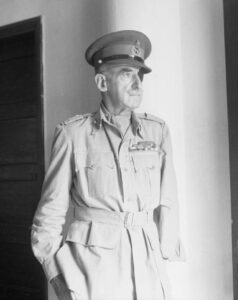 he sustained 11 grievous injuries, and simply could not be killed in war.
he sustained 11 grievous injuries, and simply could not be killed in war.
En route home via French Indochina, Carton de Wiart stopped in Rangoon as a guest of the army commander. Coming down the stairs, he slipped on coconut matting, fell down, broke several vertebrae, and knocked himself unconscious. He was admitted to Rangoon Hospital where he was treated and recovered. His wife died in 1949. Then, in 1951, at the age of 71, he married Ruth Myrtle Muriel Joan McKechnie, a divorcee known as Joan Sutherland, 23 years his junior (born in late 1903, she died January 13, 2006, at the age of 102.) They settled at Aghinagh House, Killinardrish, County Cork, Ireland. Carton de Wiart died at the age of 83 on June 5, 1963. He left no papers. He and his wife Joan are buried in Caum Churchyard just off the main Macroom road. The grave site is just outside the actual graveyard wall on the grounds of his own home.
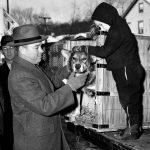
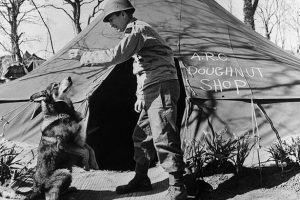 As most of us know, dogs have been used in many kinds of work from K-9 units to military units to guide dogs, to cadaver dogs, and many more. During World War II, one such dog named Chips, who was a Shepherd-Collie-Husky mix, served for 3.5 years of the war. When the US entered World War II, the military actually asked Americans to “donate” their dogs to serve on patrols and guard duty. That seems so strange to me. How could the dog know what was going on? How could it not get depressed or aggressive, thinking its owner was dead or had abandoned it? It’s one thing to send a soldier into a war situation, they have either been legally drafted or they freely joined up, but a dog…or any animal for that matter, couldn’t possibly understand why, after having a family of their own, they were suddenly in a foreign country, without their owner, their own bed, or their home.
As most of us know, dogs have been used in many kinds of work from K-9 units to military units to guide dogs, to cadaver dogs, and many more. During World War II, one such dog named Chips, who was a Shepherd-Collie-Husky mix, served for 3.5 years of the war. When the US entered World War II, the military actually asked Americans to “donate” their dogs to serve on patrols and guard duty. That seems so strange to me. How could the dog know what was going on? How could it not get depressed or aggressive, thinking its owner was dead or had abandoned it? It’s one thing to send a soldier into a war situation, they have either been legally drafted or they freely joined up, but a dog…or any animal for that matter, couldn’t possibly understand why, after having a family of their own, they were suddenly in a foreign country, without their owner, their own bed, or their home.
Nevertheless, when their country asked, over 11,000 Americans volunteered their pets, including Chips’s owner, John Wren of Pleasantville, New York. Chips the first “volunteer” dog in the United States, took part in the invasion of Sicily, just a year into his deployment. When an Italian machine gunner pinned down Chips and his squad, he broke away from his leash and charged into the enemy position. A single shot rang out. Then, the Italian gunner emerged with Chips at his throat, followed by three more soldiers. They all quickly surrendered. Chips received a wound on his scalp and burns on his mouth and left eye. That didn’t stop this hero dog, who kept fighting and helped capture 10 more soldiers that day.
After the war, per their request, it was time for Chips to be returned to his family. Plans would have to be put in place for that to happen. So, in the fall of 1945 he was taken back to Front Royal where he was retrained so that he could go back to his family. A dog who had been in combat couldn’t just go back to his family as if nothing had happened. Finally in December of 1945, he traveled home to Pleasantville, riding in the baggage car of a train. He didn’t go alone. He was accompanied by six reporters and photographers who wanted to 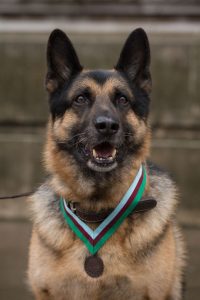
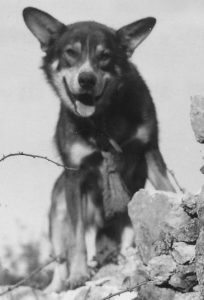 cover the story. They were met by Mr and Mrs Wren and their son, Johnny, who was only a baby when Chips left. The girls raced home after school to see their dog. It was a sweet homecoming. Chips lived for just four months before his kidneys failed. I guess war had taken its toll.
cover the story. They were met by Mr and Mrs Wren and their son, Johnny, who was only a baby when Chips left. The girls raced home after school to see their dog. It was a sweet homecoming. Chips lived for just four months before his kidneys failed. I guess war had taken its toll.
Chips’s story made him an international sensation. He received a Silver Star for his heroics. Unfortunately, some people thought that a dog shouldn’t be awarded the same medal as a human, so it was revoked. Then, in 2018, he was awarded the PDSA Dickin Award, the highest honor for wartime bravery for an animal. A well-deserved honor. While his award was amazing, I think that the family should have also received an award, as should all of the other families who donated their dogs for the war effort. It was a very selfless act.
 Many people believe that there was no good reason for the war in Vietnam. It seemed like a war we were not going to be allowed to win, and many thought it should have been one we just stayed out of. Vietnam became a French colony in 1877 with the founding of French Indochina, which included Tonkin, Annam, Cochin China and Cambodia…Laos was added in 1893. The French lost control of their colony briefly during World War II, when Japanese troops occupied Vietnam.
Many people believe that there was no good reason for the war in Vietnam. It seemed like a war we were not going to be allowed to win, and many thought it should have been one we just stayed out of. Vietnam became a French colony in 1877 with the founding of French Indochina, which included Tonkin, Annam, Cochin China and Cambodia…Laos was added in 1893. The French lost control of their colony briefly during World War II, when Japanese troops occupied Vietnam.
After the war, Japan and France continued to fight over Vietnam. Ho Chi Minh, a revolutionary leader inspired by Lenin’s Bolshevik Revolution began forming an independence movement. He established the League for the Independence of Vietnam, better known as the Viet Minh, in May of 1941. On September 2, 1945, he declared Vietnam’s independence from France, just hours after Japan’s surrender in World War II. When the French rejected his plan, the Viet Minh resorted to guerilla warfare to fight for an independent Vietnam.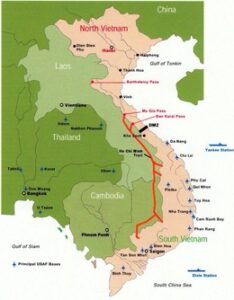
One of the most well-known campaigns of the Vietnam War was codenamed Operation Rolling Thunder. It was an American bombing campaign in which US military aircraft attacked targets throughout North Vietnam from March 1965 to October 1968. This operation was intended to put military pressure on North Vietnam’s communist leaders, thereby reducing their capacity to wage war against the US-supported government of South Vietnam. With that, operation American began its involvement began, not only its assault on North Vietnamese territory, but the expansion of US involvement in the Vietnam War.
By the 1950s, the US military began providing equipment and advisors to help the government of South Vietnam to resist a communist takeover by North Vietnam and its South Vietnam-based allies, the Viet Cong guerrilla fighters. The American military initiated limited air operations within South Vietnam in 1962, in an effort to offer air support to South Vietnamese army forces, destroy suspected Viet Cong bases, and spray herbicides such as Agent Orange to eliminate jungle cover. It was an ugly time for anyone in the area. In August 1964, President Lyndon B Johnson expanded American air operations, when he authorized retaliatory air strikes against North Vietnam following a reported attack on US warships in the Gulf of Tonkin. Later that year, Johnson approved 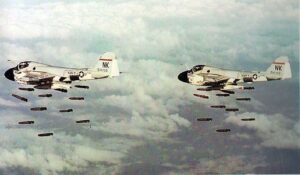 limited bombing raids on the Ho Chi Minh Trail, a network of pathways that connected North Vietnam and South Vietnam by way of neighboring Laos and Cambodia. The president’s goal was to disrupt the flow of manpower and supplies from North Vietnam to its Viet Cong allies. Nothing the United States tried really worked to remove the tensions in the area, and so in 1963, the United States withdrew from Vietnam. Unfortunately, they left behind bombs and land mines from Operation Rolling Thunder and other bombing campaigns of the Vietnam War. By some estimates, those bombs and land mines have killed or injured tens of thousands of Vietnamese people since the United States withdrew its combat troops in 1973.
limited bombing raids on the Ho Chi Minh Trail, a network of pathways that connected North Vietnam and South Vietnam by way of neighboring Laos and Cambodia. The president’s goal was to disrupt the flow of manpower and supplies from North Vietnam to its Viet Cong allies. Nothing the United States tried really worked to remove the tensions in the area, and so in 1963, the United States withdrew from Vietnam. Unfortunately, they left behind bombs and land mines from Operation Rolling Thunder and other bombing campaigns of the Vietnam War. By some estimates, those bombs and land mines have killed or injured tens of thousands of Vietnamese people since the United States withdrew its combat troops in 1973.
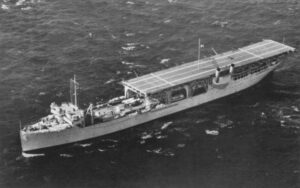 In 1912, the coal transport ship, Jupiter, was transformed, into the US Navy’s first aircraft carrier. The ship was recommissioned USS Langley (CV-1) and was the first aircraft carrier in history. As aircraft carriers go, we would have laughed about the look of this one. This recreated coal transport ship probably should have just stayed a coal transport, but then we wouldn’t have the aircraft carriers we have today, if Jupiter had not been transformed. It all had to start somewhere.
In 1912, the coal transport ship, Jupiter, was transformed, into the US Navy’s first aircraft carrier. The ship was recommissioned USS Langley (CV-1) and was the first aircraft carrier in history. As aircraft carriers go, we would have laughed about the look of this one. This recreated coal transport ship probably should have just stayed a coal transport, but then we wouldn’t have the aircraft carriers we have today, if Jupiter had not been transformed. It all had to start somewhere.
While USS Langley was the first aircraft carrier made, it was not the first to go down in battle. That “honor” goes to HMS Courageous, on September 17, 1939, only a couple weeks after World War II in Europe began. On that day, German U-boat, U-29, sunk the British aircraft carrier with 2 of the 3 torpedoes fired striking the unfortunate carrier. Courageous went down, taking 519 of her crew with her, thereby becoming the first aircraft carrier ever sunk by a submarine. The US Navy’s first aircraft carrier, the Langley, managed to survive until February 27, 1942, when it was sunk by Japanese warplanes (with a little help from US destroyers), and all of its 32 aircraft are lost.
The USS Langley was originally launched in 1912 as the naval collier (coal transport ship) Jupiter. After World 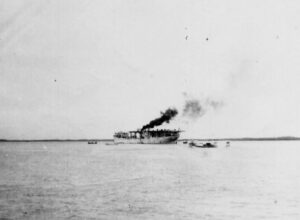 War I, the Jupiter was converted into the Navy’s first aircraft carrier and rechristened the Langley, after aviation pioneer Samuel Pierpont Langley. Uss Langley was the Navy’s first electrically propelled ship. It was capable of speeds of 15 knots. On October 17, 1922, Lieutenant Virgil C Griffin had the great honor of piloting the first plane, a VE-7-SF, from Langley’s decks. Planes had taken off from ships before, but this was a historic moment. The prestige was short-lived, and after 1937, the Langley lost the forward 40 percent of her flight deck as part of a conversion to seaplane tender, a mobile base for squadrons of patrol bombers.
War I, the Jupiter was converted into the Navy’s first aircraft carrier and rechristened the Langley, after aviation pioneer Samuel Pierpont Langley. Uss Langley was the Navy’s first electrically propelled ship. It was capable of speeds of 15 knots. On October 17, 1922, Lieutenant Virgil C Griffin had the great honor of piloting the first plane, a VE-7-SF, from Langley’s decks. Planes had taken off from ships before, but this was a historic moment. The prestige was short-lived, and after 1937, the Langley lost the forward 40 percent of her flight deck as part of a conversion to seaplane tender, a mobile base for squadrons of patrol bombers.
The Langley was part of the Asiatic Fleet in the Philippines when the Japanese attacked on December 8, 1941. Immediately setting sail for Australia, she arrived on January 1, 1942. On February 22nd, under the command of Robert P McConnell, the Langley, carrying 32 Warhawk fighters, left as part of a convoy to aid the Allies in their battle against the Japanese in the Dutch East Indies. Then, on February 27, the Langley parted company 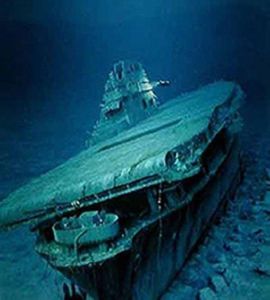 from the convoy and headed straight for the port at Tjilatjap, Java. About 74 miles south of Java, the carrier met up with two US escort destroyers. Then nine Japanese twin-engine bombers attacked the ship. Although the Langley had requested a fighter escort from Java for cover, none could be spared. She and the escort destroyers were virtually alone. The first two Japanese bomber runs missed their target, as they were flying too high, but the third time around they hit their mark three times. The planes on deck went up in flames. The carrier began to list, and Commander McConnell lost his ability to navigate the ship. In an effort to save his men, McConnell ordered the Langley abandoned, and the escort destroyers were able to take his crew to safety. Of the 300 crewmen, only 16 were lost. The destroyers then sank the Langley before the Japanese were able to capture it. It was necessary that they keep it out of Japanese hands. Better at the bottom of the sea that in the hands of the Japanese.
from the convoy and headed straight for the port at Tjilatjap, Java. About 74 miles south of Java, the carrier met up with two US escort destroyers. Then nine Japanese twin-engine bombers attacked the ship. Although the Langley had requested a fighter escort from Java for cover, none could be spared. She and the escort destroyers were virtually alone. The first two Japanese bomber runs missed their target, as they were flying too high, but the third time around they hit their mark three times. The planes on deck went up in flames. The carrier began to list, and Commander McConnell lost his ability to navigate the ship. In an effort to save his men, McConnell ordered the Langley abandoned, and the escort destroyers were able to take his crew to safety. Of the 300 crewmen, only 16 were lost. The destroyers then sank the Langley before the Japanese were able to capture it. It was necessary that they keep it out of Japanese hands. Better at the bottom of the sea that in the hands of the Japanese.
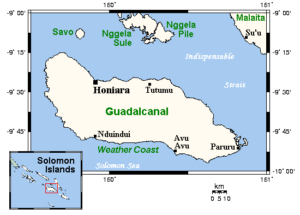 Amazingly, the islands of the world have held an importance during wartime, that most of us would never have dreamed. These seemingly insignificant places proved to be great staging places time and again, and so became places that were fought over viciously. The Solomon Islands were among those places fought over during World War II…most specifically Guadalcanal. The island of Guadalcanal is the largest of the Solomons Islands, which is in the South Pacific Ocean, located northeast of Australia. The Solomon Islands are a group of 992 islands and atolls, 347 of which are inhabited. The Solomons have 87 Indigenous languages. They were first discovered in 1568 by Spanish navigator Alvaro de Mendana de Neyra (1541-95). By 1893, the British had annexed Guadalcanal, along with the other central and southern Solomons, which made sense, since they also owned Australia. In 1885, the Germans took control of the northern Solomons, but transferred these islands, except for Bougainville and Buka (which eventually went to the Australians) to the British in 1900. So, the Solomon Islands have been transferred around some over the centuries, as most countries have been, a time or two anyway.
Amazingly, the islands of the world have held an importance during wartime, that most of us would never have dreamed. These seemingly insignificant places proved to be great staging places time and again, and so became places that were fought over viciously. The Solomon Islands were among those places fought over during World War II…most specifically Guadalcanal. The island of Guadalcanal is the largest of the Solomons Islands, which is in the South Pacific Ocean, located northeast of Australia. The Solomon Islands are a group of 992 islands and atolls, 347 of which are inhabited. The Solomons have 87 Indigenous languages. They were first discovered in 1568 by Spanish navigator Alvaro de Mendana de Neyra (1541-95). By 1893, the British had annexed Guadalcanal, along with the other central and southern Solomons, which made sense, since they also owned Australia. In 1885, the Germans took control of the northern Solomons, but transferred these islands, except for Bougainville and Buka (which eventually went to the Australians) to the British in 1900. So, the Solomon Islands have been transferred around some over the centuries, as most countries have been, a time or two anyway.
During World War II, Guadalcanal became a hard-fought-over island, with the Japanese in control in early 1943. Then, on February 8, 1943, Japanese troops evacuate Guadalcanal, leaving the island in Allied possession after a prolonged campaign. When Japan lost Guadalcanal, it paved the way for other Allied wins in the Solomon Islands.
The Japanese had invaded the Solomon Islands in 1942 during World War II and immediately began building a strategic airfield on Guadalcanal. On August 7, 1942, US Marines landed on the island, signaling the Allies’ first major offensive against Japanese-held positions in the Pacific. The Japanese response to the US Marines “boots on the ground” was to quickly launch sea and air attacks. The battles that followed were bloody and made even more miserable in the debilitating tropical heat. Nevertheless, the Marines fought hard with Japanese troops on land, and in the waters surrounding Guadalcanal, the US Navy fought six major engagements with the Japanese between August 24 and November 30. In mid-November 1942, the five Sullivan brothers from Waterloo, Iowa, died together when the Japanese sank their ship, the USS Juneau. These days they try not to put brother together in battle, but the Sullivan brothers had requested it, and so it was granted.
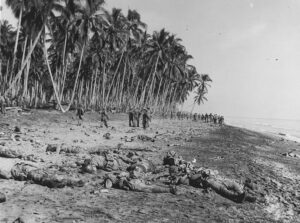
Both the United States and the Japanese suffered heavy losses of men, warships, and planes in the battle for Guadalcanal. It is estimated 1,600 US troops were killed and over 4,000 were wounded. Several thousand more died from disease. The Japanese lost 24,000 soldiers. Finally, on December 31, 1942, Emperor Hirohito told his troops they could withdraw from the area. About five weeks later, the Americans secured Guadalcanal. American authorities declared Guadalcanal secure on February 9, 1943. After the war, American and Japanese groups have repeatedly visited Guadalcanal to search for remains of missing soldiers. Some 7,000 Japanese remain missing on the island, and islanders still bring the Japanese groups bones that the islanders say are those of unearthed Japanese soldiers.
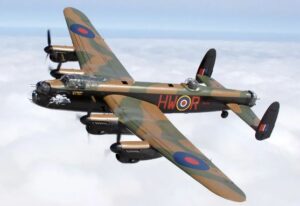 As nations prepare for war, they must also prepare the weapons of warfare. These days, and really since airplanes became reliable enough to be used in war, manufacturers have been building better and better airplanes for war. The Wright brothers, Wilber and Orville made the first airplane, which they successfully flew in 1903. Planes were first used in war in 1911, but it was in World War I, 1914-1918, that their use became commonplace. Since then, we have seen an avalanche of progress is the types and capabilities of planes.
As nations prepare for war, they must also prepare the weapons of warfare. These days, and really since airplanes became reliable enough to be used in war, manufacturers have been building better and better airplanes for war. The Wright brothers, Wilber and Orville made the first airplane, which they successfully flew in 1903. Planes were first used in war in 1911, but it was in World War I, 1914-1918, that their use became commonplace. Since then, we have seen an avalanche of progress is the types and capabilities of planes.
For me, there is no greater warplane than the B-17, but I suppose I am a bit biased because my dad served on a B-17 during World War II. That mkes me very partial to the B-17. It really was a Flying Fortress, and it was that fortress that brought my dad back home. In my book, that makes it the greatest plane ever.
During World War II, the United States had the B-17, otherwise known as the Flying Fortress…among other planes, of course. There was a plane used by Britain, that would have been the similar, to a degree to the abilities to the B-17. The Lancaster was a heavy bomber “workhorse” of a plane. When compared to the B-17, it could carry a heavier payload and fly further than the B-17. The B-17 had higher flight ceiling and better defensive firepower. Speed was about even. Those things are important, but when it came to survivability, the B-17 was the better plane in that it was far easier to bail out of than the Lancaster, meaning that the crew of a plane that was going down would really hope it 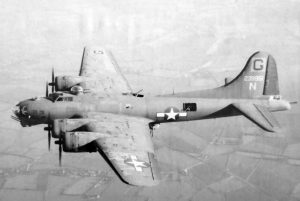 was a B-17. Only 15% of shot down crewmen survived from the Lancaster, while it was around 50% for B-17s. The Lancaster bomber had only one emergency exit…at the front of the aircraft, as opposed to four (counting the bomb bays) for the B-17.
was a B-17. Only 15% of shot down crewmen survived from the Lancaster, while it was around 50% for B-17s. The Lancaster bomber had only one emergency exit…at the front of the aircraft, as opposed to four (counting the bomb bays) for the B-17.
Both of these planes were amazing weapons of war. They were just developed, designed, and built by different companies, and different countries. They served somewhat different purposes, but they were both designed to end the murderous Axis of Evil nations, of which Hitler’s Third Reich and Japan’s evil empire were a huge part. These planes were different, but both were on the side of good and not evil. I think that I am just glad they were on the same side of the war.
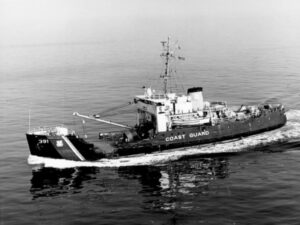 The USCGC Blackthorn (WLB-391) was a 180-foot seagoing buoy tender for the US Coast Guard. A buoy tender is a type of vessel used to maintain and replace navigational buoys. Prior to navigational buoys, ships might run into rocks, small almost submerged islands, or coral reefs. It would be nice if every underwater danger could have a lighthouse, but that just isn’t feasible. Buoys, on the other hand, and markers serve to direct the operator of the water vessels on the safe course to take. They warn the operator of the underlying dangers in the waterways. Navigation buoys and markers are also effective navigation aid in directing the water vessel operator on the best route to use. They aid in determining the safest way through the waters.
The USCGC Blackthorn (WLB-391) was a 180-foot seagoing buoy tender for the US Coast Guard. A buoy tender is a type of vessel used to maintain and replace navigational buoys. Prior to navigational buoys, ships might run into rocks, small almost submerged islands, or coral reefs. It would be nice if every underwater danger could have a lighthouse, but that just isn’t feasible. Buoys, on the other hand, and markers serve to direct the operator of the water vessels on the safe course to take. They warn the operator of the underlying dangers in the waterways. Navigation buoys and markers are also effective navigation aid in directing the water vessel operator on the best route to use. They aid in determining the safest way through the waters.
The Blackthorn was one of 39 original 180-foot seagoing buoy tenders built between 1942-1944. All but one of the original tenders, USCGC Ironwood (WLB-297), were built in Duluth, Minnesota, which makes me wonder if my Uncle Bill Spencer, or his sisters, Laura Fredrick and Ruth Wolfe might have worked on it. Blackthorn’s preliminary design was completed by the United States Lighthouse Service and the final design was produced by Marine Iron and Shipbuilding Corporation in Duluth. On May 21, 1943, the keel was laid, the vessel was launched on July 20, 1943, and commissioned on March 27, 1944. The original cost for the hull and machinery was $876,403.
The Blackthorn was initially assigned to the Great Lakes for ice-breaking duties, but was resigned to San Pedro, California after just a few months. For several years the vessel served in San Pedro and then it was moved to the gulf coast region to serve in Mobile, Alabama. From there it was transferred to Galveston, Texas for the final years of its service until it was involved in an accident.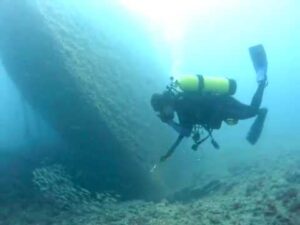
In 1979-1980, Blackthorn underwent a major overhaul in Tampa, Florida. The work was finished and on January 28, 1980, while leaving Tampa Bay after the completion of the overhaul, she collided with the tanker SS Capricorn near the Tampa Bay Sunshine Skyway Bridge. The Blackthorn capsized resulting in the deaths of 23 crew members. The cutter was raised for the investigation, but ultimately, instead of fixing it, Blackthorn was scuttled in the Gulf of Mexico after the investigation was complete. She is currently serving as an artificial reef for recreational diving and fishing.

